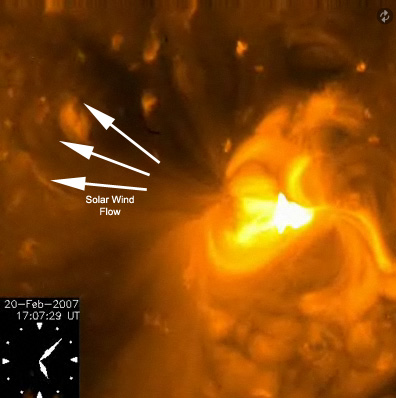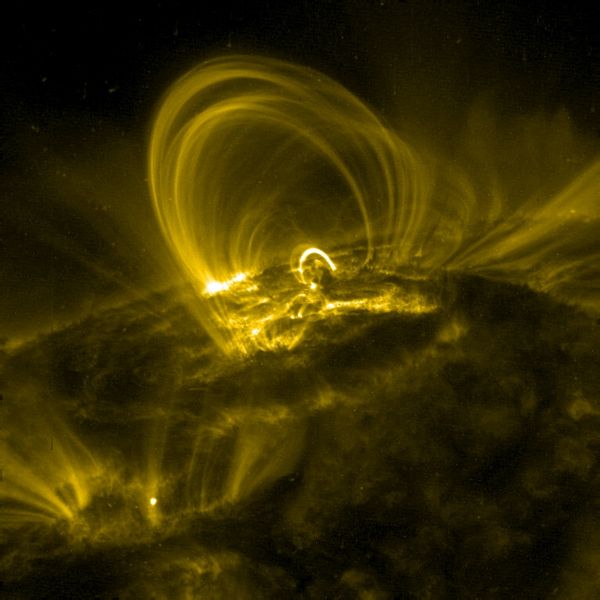|
|||||||
|
|
|
 |
|
|
Strumenti |
|
|
#1 |
|
Bannato
Iscritto dal: Aug 2001
Città: Berghem Haven
Messaggi: 13526
|
Trovata la fonte del vento solare LENTO
Prima di tutto ecco il video, perchè so che correreste subito al link
http://www.esa.int/esaSC/SEMJQK5QGEF_index_1.html Articolo: http://www.universetoday.com/2008/04...d-found-video/  The solar wind comes in two modes: fast and slow. Solar astronomers have a good idea as to where the fast solar wind comes from: polar coronal holes of open magnetic field lines, blasting solar particles at speeds of over 3 million km/hr. But what about the slow solar wind which fires particles into space at a pedestrian 1.5 million km/hr? We know it comes from the streamer belt above equatorial regions of the Sun, but we have never been able to look lower. But now, with the help of the Hinode observatory, stunning high-resolution images and video have been captured showing solar dynamics previously overlooked. The point at which the Sun ejects slow wind particles into space can now be studied in unparalleled detail to help us understand the dynamics of space weather and solar storms. The Sun is a complex, magnetic body. Its magnetic field is highly dynamic, varying in activity throughout the 11-year solar cycle. We have just witnessed the Sun entering "Solar Cycle 24" (although some old sunspots from the previous cycle have just been seen) and it will gradually build in energy before reaching "solar maximum" in a few years time (looks like the solar storms will be bigger than 2003's flare excitement). Transition Region and Coronal Explorer image of coronal loops (credit: NASA) This time of relative calm (known as "solar minimum") allows solar physicists to study the less explosive dynamics in the lower corona (the Sun's atmosphere), chromosphere and photosphere. It is in this region that magnetic field lines (or magnetic flux) are pushed through the photosphere and the plasma from the solar interior is guided by the magnetic flux high into the corona. These hot and bright arcs of magnetism and superheated plasma are known as coronal loops, the scene of rapid reconnection events, sometimes sparking flares and coronal mass ejections (CMEs). But this time the Hinode science team have observed a steady release of solar plasma, venting from the solar interior around a cluster of bright coronal loop footpoints. The location of this steady release of plasma forms the origin of the slow solar wind. These dazzling images were captured by the Extreme Ultraviolet Imaging Spectrometer (EIS) on board the Japanese Hinode solar observatory. The observatory, which orbits the Earth, constantly looking at the Sun, has given us unrivaled observations of the Sun in X-ray and EUV wavelengths. Launched by Japan, the project also has collaborators in the UK and US. These new discoveries are of vast importance to us. The solar wind carries a stream of highly energetic particles from the Sun and into space. The solar wind bathes the Earth in a radioactive stream, carrying the remnants of the solar magnetic field with it. The magnetic field can interact with the Earth's magnetic field, allowing solar particles to rain down on our Polar Regions, creating vast light displays: the Aurora. However, these particles are also highly dangerous to any unprotected astronaut or sensitive satellite orbiting our planet. It is of paramount importance that as we venture further and further into space that we forecast the characteristics of the solar wind before it hits us. These new observations will aid our understanding of the conditions at the solar wind source and greatly improve our space weather-predicting ability. 
|
|
|

|
|
|
#2 |
|
Bannato
Iscritto dal: Jun 2007
Messaggi: 460
|
|
|
|

|
|
|
#3 | |
|
Bannato
Iscritto dal: Jun 2007
Messaggi: 460
|
Quote:
|
|
|
|

|
|
|
#4 |
|
Senior Member
Iscritto dal: Jun 2007
Messaggi: 1624
|
|
|
|

|
|
|
#5 |
|
Bannato
Iscritto dal: Aug 2001
Città: Berghem Haven
Messaggi: 13526
|
|
|
|

|
|
|
#6 | |
|
Senior Member
Iscritto dal: Mar 2007
Città: Pe-Ch
Messaggi: 19332
|
Quote:
__________________
|
|
|
|

|

|
| Strumenti | |
|
|
Tutti gli orari sono GMT +1. Ora sono le: 11:53.























